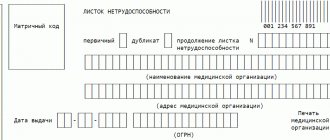What is accounts receivable and how to avoid writing it off?
Accounts receivable (RA) are the debts of counterparties (legal entities and individuals, including company employees) for delivered products (goods, services).
The occurrence of DZ is due to a number of reasons, including:
- sales of products with deferred payment;
- purchase of raw materials and other property on an advance payment basis with a delay in delivery;
- insolvency of counterparties or their dishonesty;
- other similar reasons.
Receivables are funds diverted from circulation, and it is important for a company to properly structure work with such debts so that diverted funds are returned to circulation in a timely manner, and hopeless funds and those with expired statutes of limitations are written off on time.
In order not to lose finances, not to “delay” payment relationships with debtors and not to divert resources to processing the write-off of debt, it is necessary to properly organize comprehensive work with receivables, including:
- debt planning (dividing debts into critical and working);
- organization of work with defaulters (formation of regulations for working with contractors on debt claims, setting deadlines for sending reminders to debtors about debt repayment, appointment of responsible persons for representing the interests of the company in collecting debt claims in court, etc.).
Writing off receivables in tax accounting has its own peculiarities. ConsultantPlus experts explained in detail how to correctly reflect write-offs in tax accounting. Full trial access to the K+ system can be obtained for free.
Financial specialists and accounting employees perform their functions in this set of activities, including:
- monitoring the timing of payment of debt in accordance with concluded agreements in order to form a reliable amount of the reserve for doubtful debts;
- regular inventory of debts;
- timely identification of debts with expired statute of limitations and bad debts.
If, as a result of working with the receivable, it was not possible to collect or reclaim some of the debts, they must be written off from the accounting accounts in a timely manner. What kind of transactions accompany the write-off of accounts receivable will be discussed in the next section.
On our forum you can clarify the correct solution to any problem that you encounter during accounting. For example, here they will help you understand how to write off the advance payment received from the buyer after the statute of limitations has expired.
Find out more about the types and accounting nuances of financial statements (including from the standpoint of IFRS) from the materials on our website:
- “Accounts receivable are...”;
- “Accounting for accounts receivable according to IFRS.”
How is an overdue but not bad debt reflected in accounting and reporting?
Overdue debt recognized as doubtful is also not reflected in the balance sheet - in accounting, outstanding and unsecured debt is subject to mandatory reservation.
The created reserve reduces the accounts receivable reflected in the accounting - in the balance sheet, the amount of accounts receivable on line 1230 should be reflected minus such reserved amounts.
To assess a debtor's debt as doubtful (for the purpose of creating a reserve), you must:
- develop and consolidate in the accounting policy criteria for classifying debts as doubtful;
- assess the probability of debt repayment on a regular basis (at each reporting date);
- when the likelihood of debt repayment increases, review doubtful debt according to the criteria and adjust the amount of the reserve.
The amount of the reserve is determined (clause 70 of the Regulations on accounting and reporting, approved by order of the Ministry of Finance of the Russian Federation dated July 29, 1998 No. 34n):
- separately for each doubtful debt;
- taking into account the solvency of the debtor;
- based on an assessment of the likelihood of debt repayment.
Deductions to the reserve are other expenses (clause 11 of PBU 10/99 “Expenses of the organization”, approved by order of the Ministry of Finance of the Russian Federation dated May 6, 1999 No. 33n).
The article “Other expenses in accounting are…” will tell you more about other expenses.
Read on to learn about overdue accounts receivable, which need to be cleared from accounting and reporting, as well as what accounting nuances need to be taken care of.
Write-off of overdue accounts receivable – postings
Writing off debt is a process that is necessary and important for any company. It allows:
- generate information about real debts to be repaid or required to be collected;
- reflect it reliably in reporting.
To write off accounts receivable, entries can be of two categories:
Basic:
- Dt 63 Kt 62 (76, 60, 58. 3) - written off DZ due to the reserve for doubtful debts;
- Dt 91-2 Kt 62(76, 60, 58. 3) - DZ not covered by the reserve was written off.
Additional:
Dt 007 - reflection of the written-off DZ on the balance sheet (within 5 years).
Find out what happens with VAT when you write off a property loan from the Ready-made solution from ConsultantPlus. Trial access to the system can be obtained for free.
To reflect the write-off of property in accounting, it is not enough to use the indicated transactions - you must first carry out a number of organizational and design procedures:
- create an inventory commission and, within the time limits established by the order, carry out an inventory of the property, documenting its results in a separate document (for example, in an act form No. INV-17 or another document independently developed by the company and approved in its accounting policy);
- take measures to restore documents confirming the presence, type and size of the remote control if, as a result of the inventory, their absence or insufficiency is revealed (clause 1, article 9 of the law dated December 6, 2011 No. 402-FZ);
- issue an order to write off the receivables (clause 77 of the Regulations on accounting and reporting, approved by order of the Ministry of Finance of Russia dated July 29, 1998 No. 34n).
The material “Inventory of receivables and payables” will help you learn more about the inventory procedure.
Only after all preliminary procedures is it possible to write off the debt from the accounting accounts. In this case, special attention must be paid to the corresponding accounts - write-off of receivables according to accounting standards can occur due to the reserve formed not only for regular receivables reflected in accounts 60, 62 and 76 (sellers, buyers, customers and other debtors), but also in correspondence with account 58.3, which reflects issued loans. For tax accounting purposes, this approach is unacceptable - more on that in the next section.
Criteria and procedure for writing off unrealistic (uncollectible) and doubtful debts
Accounts receivable can be written off from the balance sheet on two grounds (letters of the Ministry of Finance of Russia dated April 17, 2019 No. 02-07-10/27662, dated October 25, 2019 No. 02-07-10/82363, dated March 6, 2020 No. 02-06-10 /17162, dated June 25, 2020 No. 02-07-05/54811):
- If the debt is recognized as doubtful;
- If the debt is deemed uncollectible.
Doubtful debt is the amount of recognized income for which a receivable has been identified that was not fulfilled by the debtor (payer) on time and does not meet the criteria for recognition of an asset (clause 11 of the “Revenue” Standard, approved by order of the Ministry of Finance of Russia dated February 27, 2018 No. 32n).
Debt is considered doubtful if there are documents confirming the uncertainty regarding the receipt of economic benefits or useful potential.
The grounds for recognizing a debt as doubtful (not corresponding to an “asset”) include the lack of confidence that funds will be received in the foreseeable future (at least three years from the year in which the statements are prepared) to repay the receivables.
Doubtful debts are written off from the balance sheet and taken into account as off-balance sheet. On the off-balance sheet, doubtful debts are taken into account until they are recognized as unrecoverable (uncollectible).
Uncollectible (uncollectible) debt is the amount of recognized income for which the obligation to pay the debt, the right to collect the debt has been terminated, and there is uncertainty regarding the receipt of economic benefits or useful potential.
More on the topic: Standard “Rent”: when budgetary institutions may not apply its provisions
The grounds for recognizing a debt as unrealistic (unreliable) for collection are listed in Art. 47.2 of the Budget Code of the Russian Federation, clause 7 of the Standard “Event after the reporting date”, approved. by order of the Ministry of Finance of Russia dated December 30, 2017 No. 275n.
These include:
- death of an individual - debtor or declaration of death;
- declaring the debtor bankrupt;
- liquidation of the debtor organization in terms of debt on payments not repaid due to the insufficiency of the organization’s property and (or) the impossibility of repayment by the founders (participants) of the said organization;
- adoption by the court of an act according to which the institution loses the ability to collect debt from the debtor due to the expiration of the collection period (statute of limitations), including the court’s issuance of a ruling refusing to restore the missed deadline for filing an application to the court for debt collection;
- the issuing of a resolution by the bailiff to terminate the enforcement proceedings and to return the writ of execution to the recoverer.
The list of documents required to make a decision to recognize a debt as uncollectible is contained in paragraphs. “c” clause 3 of the order, approved. Decree of the Government of the Russian Federation dated May 6, 2016 No. 393.
A debt that is unrealistic (uncollectible) when written off from the balance sheet is not accepted for off-balance sheet accounting (clause 339 of the Instructions, approved by Order of the Ministry of Finance of Russia dated December 1, 2010 No. 157n, hereinafter referred to as Instruction No. 157n). Recognizing the debt as unrealistic (bad) is also the basis for writing off amounts from the off-balance sheet account.
The decision to write off unrealistic (uncollectible) or doubtful debts is made by the commission for the receipt and disposal of assets (clause 339 of Instruction No. 157n). The procedure and documentation of this procedure is established in the accounting policy (letter of the Ministry of Finance of Russia dated February 18, 2014 No. 02-06-10/6776).
When writing off debt from accounting, the following can be issued:
- inventory list of settlements with buyers, suppliers and other debtors and creditors (f. 0504089) with the attachment of documents confirming the existence of debt;
- documents confirming the uncertainty regarding the receipt of economic benefits or useful potential;
- decision of the institution’s commission on the receipt and disposal of assets;
- written justification for the decision to write off debt;
- order (instruction) of the head of the institution to write off the debt;
- accounting certificate (f. 0504833).
More on the topic: Coronavirus: the reason for the cancellation of business trips and events in budgetary institutions
How to write off bad receivables in tax accounting
It is possible to write off debt in tax accounting in the following order:
- at the expense of the reserve for doubtful debts formed under clause 5 of Art. 266 Tax Code of the Russian Federation;
- reflect the DZ as part of non-operating expenses (subclause 2, clause 2, article 265 of the Tax Code of the Russian Federation).
It should be clarified that not all overdue and unsecured receivables allowed in accounting fall into the tax reserve. For the purposes of tax accounting, only DZ is reserved that is directly related to the sale of goods (works, services).
When writing off receivables, quite a lot of controversial situations arise. You will find a selection of law enforcement practices on many of them in K+. Get free trial access, go to the Encyclopedia of Dispute Situations and find out, for example, whether it is possible to take into account the liability in expenses if you have not taken measures to collect it; or if the debtor is declared inactive and excluded from the Unified State Register of Legal Entities by tax authorities, etc.
In addition, you need to remember the following important nuances:
- writing off debt will directly increase non-operating expenses if the company decides not to create a tax “doubtful” reserve - unlike accounting in tax accounting, this reserve does not need to be created;
- Companies that use the cash method of calculating income tax are forced to write off their income tax immediately as part of non-operating expenses - the formation of a reserve for them is not provided for by law.
Determining the amount of debt taken into account when creating a reserve
Now it is necessary to figure out what amount of debt is required to create an estimated liability. The amount of debt taken into account when creating a reserve depends on the period of occurrence of the debt. This aspect is regulated by tax legislation. The total amount of the estimated liability created by the accounting department on the basis of internal legal acts cannot be more than a tenth of the organization’s total revenue for this period (see → creation of a reserve for doubtful debts in accounting + postings in 2021).
| Date of occurrence | Debt amount |
| Exceeds 90 days from the date of violation of the deadline for fulfilling payment obligations | The reserve takes into account the entire amount of debt |
| From 45 days to 90 days | The reserve takes into account only half of the amount of existing debt |
| Debts up to 45 days | With this period, no reserve is created |
Accounting entries to create a reserve for doubtful debts:
| Debit | Credit | Description |
| 91 | 63 | Creation of a reserve for doubtful debts |
| 50 (51) | 62 (73, 76…) | Repayment of existing debt by the counterparty |
| 63 | 91 | Restoration of a previously created reserve after repayment of debt |
Results
Writing off accounts receivable is a multi-stage procedure, including organizational (creating a commission and conducting an inventory), registration (documentation of orders and inventory acts) and accounting (making accounting entries) steps.
It is possible to write off receivables through the reserve for doubtful debts or directly as part of expenses (other - in accounting, non-operating - in tax accounting).
You can find more complete information on the topic in ConsultantPlus. Free trial access to the system for 2 days.
Accounting entries for debt recovery
When funds are received to repay doubtful debts, the amounts are written off from off-balance sheet accounting and taken into account in the corresponding balance sheet accounts for accounting for settlements. The balance sheet records entries that are “reverse” to those entries that were used when writing off receivables from the balance sheet (letter of the Ministry of Finance of Russia dated February 11, 2016 No. 02-07-10/7306).
More on the topic: Customer actions regarding the report on the execution of contract stages will be simplified from July 1, 2021
Example. The institution's commission decided to write off doubtful receivables for prepayment for materials from the balance sheet to the off-balance sheet to monitor the possibility of collection. The debtor's property status has changed and funds to repay receivables have been transferred to the personal account.
Decrease in off-balance sheet account 04 – debt is written off from off-balance sheet accounting;
Debit KRB 2,206 34,564 Credit KRB 2,401 20,273 – the debt was accepted onto the balance sheet.
Reflection of doubtful debts in 1C
Currently, almost all organizations keep records of their activities in specially purchased software adapted to various legal and functional nuances inherent in this particular organization. These software simplify record keeping, error detection, information storage and aggregation of existing data.
In accordance with accounting, the reserve for doubtful debts in the specialized 1C program is reflected by filling out the appropriate tabs on the debit of account 91.02 and on the credit of account 63, where the amount (amount) of the reserve being created is also indicated.









